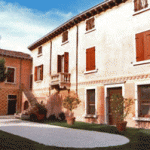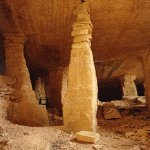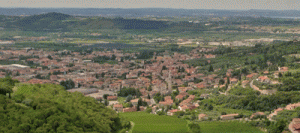The town of Sant ‘Ambrogio Valpolicella is part of the beautiful hills of Valpolicella. The climate is mild, almost Mediterranean, of this land a few kilometers from Lake Garda, is unique about the landscape and its fruits, among which stands out the fine wine Valpolicella doc. What makes this area of international renown are the Verona marble and granite that are  processed and marketed here since Roman times.To visit in Sant ‘Ambrogio, in addition to the typical districts in stone and the churches, makes the landscape characteristic of the presence of Venetian villas, the result of choice by many of
processed and marketed here since Roman times.To visit in Sant ‘Ambrogio, in addition to the typical districts in stone and the churches, makes the landscape characteristic of the presence of Venetian villas, the result of choice by many of  the nobles of Verona and Venice to spend here the periods of vacation since the Renaissance: Villa Alighieri Serego in Gargagnago and Villa Nichesola-Conforti in Ponton are among the most important of Valpolicella. There are many testimonies of the Roman presence in this area, you must certainly see the church in the village of San Giorgio, a precious example of Romanesque architecture and art thanks to the ancient Lombard ciborium that keeps inside. These places are in short, a perfect destination for tourism, made the sweetness of landscapes, architectural beauty combined with the history and flavors of good food.
the nobles of Verona and Venice to spend here the periods of vacation since the Renaissance: Villa Alighieri Serego in Gargagnago and Villa Nichesola-Conforti in Ponton are among the most important of Valpolicella. There are many testimonies of the Roman presence in this area, you must certainly see the church in the village of San Giorgio, a precious example of Romanesque architecture and art thanks to the ancient Lombard ciborium that keeps inside. These places are in short, a perfect destination for tourism, made the sweetness of landscapes, architectural beauty combined with the history and flavors of good food.
 processed and marketed here since Roman times.To visit in Sant ‘Ambrogio, in addition to the typical districts in stone and the churches, makes the landscape characteristic of the presence of Venetian villas, the result of choice by many of
processed and marketed here since Roman times.To visit in Sant ‘Ambrogio, in addition to the typical districts in stone and the churches, makes the landscape characteristic of the presence of Venetian villas, the result of choice by many of  the nobles of Verona and Venice to spend here the periods of vacation since the Renaissance: Villa Alighieri Serego in Gargagnago and Villa Nichesola-Conforti in Ponton are among the most important of Valpolicella. There are many testimonies of the Roman presence in this area, you must certainly see the church in the village of San Giorgio, a precious example of Romanesque architecture and art thanks to the ancient Lombard ciborium that keeps inside. These places are in short, a perfect destination for tourism, made the sweetness of landscapes, architectural beauty combined with the history and flavors of good food.
the nobles of Verona and Venice to spend here the periods of vacation since the Renaissance: Villa Alighieri Serego in Gargagnago and Villa Nichesola-Conforti in Ponton are among the most important of Valpolicella. There are many testimonies of the Roman presence in this area, you must certainly see the church in the village of San Giorgio, a precious example of Romanesque architecture and art thanks to the ancient Lombard ciborium that keeps inside. These places are in short, a perfect destination for tourism, made the sweetness of landscapes, architectural beauty combined with the history and flavors of good food.
TERRITORY OF SANT’ AMBROGIO VALPOLICELLA
Province: Verona
Hamlets: Domegliara, Gargagnago, Monte, Ponton, San Giorgio
Surrounding municipalities: Cavaion Veronese, Dolcè, Fumane, Pastrengo, Pescantina, Rivoli Veronese, San Pietro in Cariano
HISTORY OF SANT’ AMBROGIO VALPOLICELLA
The first traces of history in the territory of Sant’ Ambrogio Valpolicella have their origins in the Bronze and Iron Ages. The oldest evidence leads us to the beginning of the fourth century BC and is a rock-hewn cistern probably due to the activity of metalworking. Back to the end of the same century the foundations of a home laboratory, place of manufacture of bronze and iron which was used for making tools. Based on the found objects you may think that those who lived this settlement was part of the original population of Valpolicella, the Arusnates. This name can be deduced from the discovery of two plaques, Sant’ Ambrogio and Fumane, by the historian Scipione Maffei at the beginning of the eighteenth century. The Arusnati, probably of Etruscan origin, dependent in Roman times of Verona but retained their religion, cults and a certain administrative autonomy: the Pagus Arusnatium. It had its center in San Giorgio, location probably also the center of religious evidenced by fragments found here more than 200 votive earthenware figurines of gods, bidders animals. Its Romanesque church will also witness, later, through the Longobard art of ciborium “Mastro Orso” that is inside. If Roman castrum San Giorgio was, that fortified village, under the Longobard domination was “curtis regia“, that part of the royal court. The Roman presence is powerfully: date back to that period are two sacrificial preserved in the square of the parish church of Sant’Ambrogio, the names of some districts as Carazan Corgnan, burials, funerary inscriptions, votive offerings and the presence of architectural remains. Even then the area of Sant’ Ambrogio was known for the extraction and processing of limestone Verona. This activity favored by the proximity of the river Adige has continued over the centuries with medieval masters and families of quarrymen and stonecutters from ‘400 that are active in the area. Today Sant’ Ambrogio Valpolicella, with the hamlet of Domegliara, with its marble industries and has a worldwide reputation.
TO VISIT IN SANT’AMBROGIO VALPOLICELLA
Villa Serego-Alighieri, Villa Brenzoni, Villa Nichesola-Conforti, Villa Rovereti, Museo della Pieve di San Giorgio, Pieve di San Giorgio di Valpolicella, Chiesa di San Zeno, Chiesa di Santa Maria della Misericordia, Parrocchia di Sant’ Ambrogio
LOCAL PRODUCTS OF SANT’ AMBROGIO VALPOLICELLA
Valpolicella wine, marble,
